Fifteen years ago, when the planning process for extending the primary runway at Warwick’s T.F. Green Airport had already started, projections of airport use showed nothing but growth, with the expectation of 11 million passengers by 2020.
As it turned out, those predictions were more hopeful than accurate. Airport passenger traffic topped out in 2005 at about 6 million then plummeted. Although that traffic is climbing again, Rhode Island and federal officials now project an annual 2 percent growth rate at Green.
The hope is the airport will see 5 million passengers within the next five years, but there’s no guarantee even those more cautious projections will pan out.
Yet airport and city officials insist the $250 million upgrade completed this past summer was worth that significant investment. They say it allowed for safety improvements on the tarmac and opens possibilities for expanded international trade and domestic commerce. Investment in infrastructure is a long game, noted Iftikhar Ahmad, the current CEO and president of R.I. Airport Corp.
The Federal Aviation Administration’s current 2 percent projection of future traffic growth at Green is considered an aggressive goal, even with the newly completed runway, he said.
“We went from 6 million passengers in 2005 to last year, 3.6 million,” Ahmad said. “We became a very small airport. What we’re doing now is we’re trying to grow. What is our job? Our job is to work toward economic development for our community.”
The $250 million investment, about half paid through federal funds, was noted at a ceremony at the airport in September. As Ahmad introduced various dignitaries on hand to mark the completion of the runway for longer-distance flights, he paused to let the noise of an ascending aircraft subside.
The jet was from Frontier Airlines, one of four carriers that entered T.F. Green this year.
“This project represents just under one-quarter of a billion dollars,” said Ahmad. “It is a solid investment in our infrastructure and Rhode Island’s economy.”
Elements that can make or break an airport include its location and surrounding population. But without the proper infrastructure in place, he said, “It becomes very difficult to position and market any airport. The vision that began in 1999 to expand this critical runway has provided us with the necessary infrastructure to do just that.”
[caption id="attachment_180026" align="aligncenter" width="640"]
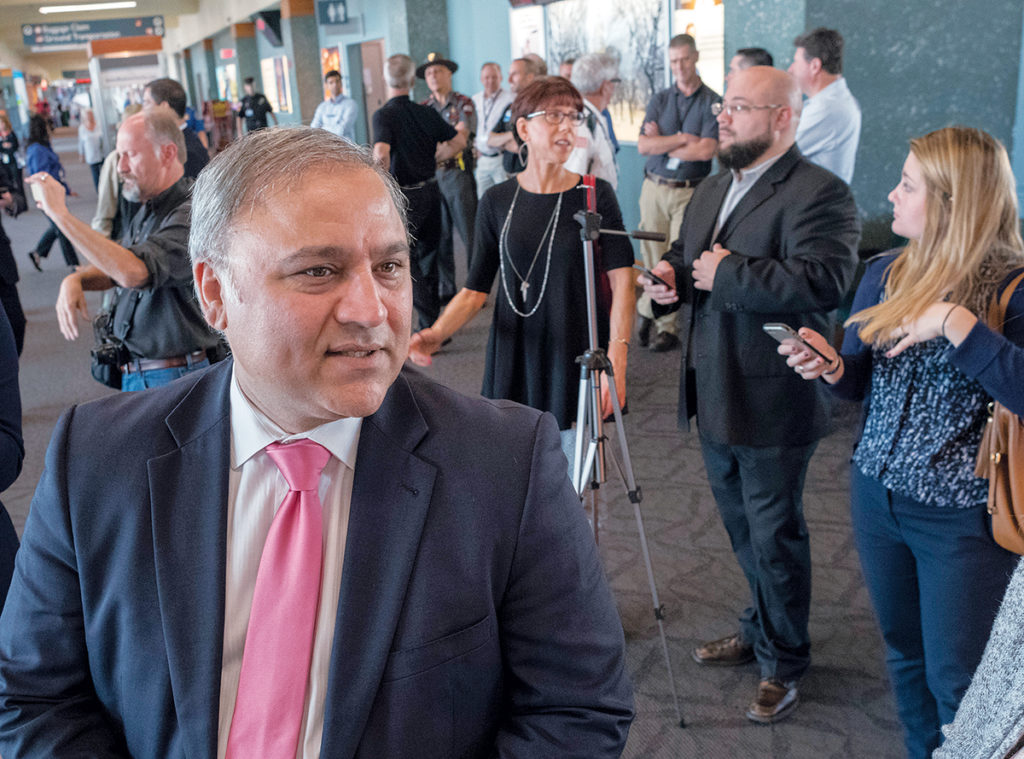
FIRST ARRIVAL: Iftikhar Ahmad, foreground, president and CEO of R.I. Airport Corp., greets passengers on the first flight of Allegiant Air, as it arrives at T.F. Green Airport. / PBN PHOTO/MICHAEL SALERNO[/caption]
IS IT A DRAW?
How critical is this runway? Like any infrastructure, it creates a conduit for further expansion and economic development. The runway extension is seen by airport, state and city officials as opening Rhode Island’s economic future.
After a furious pace of expansion, four airlines and 16 direct destinations, including to a swath of western Europe, the focus in the next several years will be marketing and service “so it will stick,” Ahmad said in a recent interview.
The runway, which has not been officially certified yet by the FAA, nonetheless was critical in attracting the new carriers, he said.
In at least one case, Norwegian Air, the new carriers would not have entertained entering the Rhode Island market but for anticipation of a longer runway, according to Ahmad.
Norwegian most certainly would have enacted weight restrictions on its flights had the runway not been extended from 7,200 feet to 8,700 feet, he said. As a practical matter, this means fewer passengers would be allowed on flights or shorter flight paths, leaving out much of Europe.
He explained why the length is critical: The full length of the runway is needed for takeoff. An aircraft needs to reach a certain speed to be able to take off with the greater weight of the larger aircraft used in international and transcontinental flights.
“If you don’t have the longer runway, you can’t have some of these flights that are longer-stage length,” Ahmad said. “This was one of those requirements we needed to have, to get Rhode Island situated for progress, basically connecting it to the rest of the world.”
[caption id="attachment_180024" align="aligncenter" width="640"]
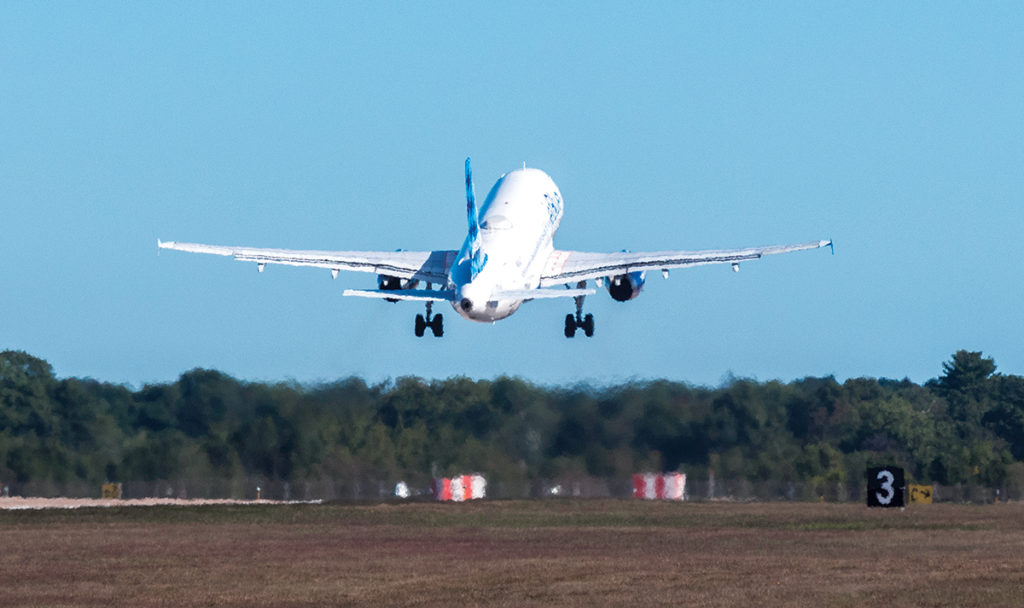
TAKING OFF: A Jet Blue flight leaves from the main runway at T.F. Green Airport, which recently completed expansion from 7,200 feet to 8,700 feet. The expansion was instrumental in attracting four new airlines with 16 direct-flight destinations to the Warwick airport this year. / PBN PHOTO/MICHAEL SALERNO[/caption]
The runway extension was completed in mid-August and was used soon after by the airport’s carriers. If visibility was obscured, or required the use of navigational aids, those flights had to use the existing runways. The FAA is scheduled to certify the completed runway for instrument-dependent landings and takeoffs in early December.
The longer runway will allow T.F. Green to make a play for transcontinental flights. The airport offers no direct service to California destinations, for example.
But the immediate priority, Ahmad said, is to make sure that the additional seats now coming to Green will stay, that the marketing of the airport and state is effective and can attract travelers consistently.
Signs are optimistic, he said. Seat capacity for next spring, based on already-scheduled flights, is 25 percent greater than this past spring, he said. The focus will be on filling them.
“We have to get some base,” Ahmad said. “We have to engage in some marketing, marketing our state, and then make a play for the West Coast.”
John Boyd, a New Jersey-based site-selection specialist who has worked for Rhode Island companies, said Green is becoming more of an asset to business in Rhode Island. When companies in the finance or banking sector want to enter a smaller, lower-cost market, they want access to a regional airport with direct flights.
“You want to be near Logan,” he said. “You want to be near access to global markets. But you want close-in access to regional flights. The buzzword we have is executive time in transit.”
Executives want an easy-access airport that doesn’t consume the workday for themselves, or staff. This includes time to park and get through security. “Corporate travel remains a vital part of the site-selection process,” said Boyd, a principal of The Boyd Co. Inc., of Princeton, N.J. “We know about the remote workforce. But corporate travel is still a big part of a company’s calculations.”
In that, he said, Green’s expanded runway is a smart investment, because it will reduce that time-in-transit on every direct flight.
‘I can leave in the morning in Providence, and have lunch with the team in Boulder, which is pretty good.’
NICK KISHFY, MojoTech CEO
One Rhode Island company that already has made use of the expanded service is MojoTech. The Providence-based custom software-development company has an office in Boulder, Colo.
It’s now accessing new service through Frontier into Denver. CEO Nick Kishfy said it’s convenient enough to allow him to use T.F. Green instead of Logan in Boston, and get in and out of the airports quickly. T.F. Green used to offer seasonal service to Colorado, to coincide with the ski season, but the Frontier service is year-round.
Kishfy expects his company to use the service about 100 times a year. This includes plans for their Christmas party, when he typically flies the Boulder staff and their spouses to Providence. Kishfy said so far, it’s worked well.
“I can leave in the morning in Providence, and have lunch with the team in Boulder, which is pretty good,” Kishfy said.
THE STRATEGY
Even without the expanded runway, T.F. Green has an economic impact estimated at several billion dollars.
A study published in 2006 found the commercial airport was responsible for $1.96 billion in economic activity, and 21,857 jobs in Rhode Island, both through direct and indirect employment.
At the time, air passenger traffic had grown dramatically, from 2.2 million in 1995 to 5.7 million. The airport alone employed 2,014 people, according to the economic-impact study, commissioned by the R.I. Airport Corp.
A more recent indication, published by the Federal Aviation Administration in 2012, found the Rhode Island airports had an impact of $2.6 billion on the economy, and contributed to 22,443 jobs. As a percent of the state’s GDP, aviation accounted for 3.1 percent.
The runway-extension project, for which planning began in 1999, included not only the lengthened pavement and new signage and drainage systems, but also improved safety components. This includes an end-of-the-runway safety zone, populated with a bed of 2,646 concrete, crushable blocks designed to slow aircraft that overrun the runway.
Other project-related elements included the demolition of Hangar 1, a residential sound-insulation program and construction of a Glycol facility.
When a 20-year master plan was developed for Green by local authorities, and approved by the FAA in April 2002, the future was laid out in a series of growth scenarios.
The one chosen for Green, a “medium” growth rate, projected that passenger demand would double from the 5.4 million recorded in 2000 to 11 million in 2020.
Instead, passenger traffic at Green started to fall by 2005. Airline analysts say the traffic fell as passengers increasingly turned to Logan International Airport in Boston with the arrival of discount service via Southwest Airlines, and the completion of the “Big Dig” tunnel project that had deterred easy access to the airport.
Once that happened, passenger traffic at Green declined steadily, dropping to 3.57 million in 2015. The counts began to rebound in 2016, climbing to 3.65 million. And that has appeared to continue to be the case.
Through August, the annual count for 2017 was 3.4 percent higher than in the previous year.
Cargo statistics also show an increase this year, 2.4 percent higher at 17.7 million pounds through August, according to T.F. Green figures.
Cargo can include mail, as well as bulky goods. It is an area of service that doesn’t get as much public attention as passenger traffic, but which may have more impact in economic development.
In addition to the large, dedicated cargo carriers at Green, such as Federal Express and United Parcel Service, passenger airlines carry cargo in their bellies. Because the runway length is now enlarged, this will free carriers to add additional cargo for transport.
Until the runway was extended, the longer-distance planes were taking off without full weight. For some, that meant restricting passenger baggage. The understanding that that runway would come online was very important for carriers wanting to add Providence as a new destination, said Bill DePasquale, director of planning for Warwick.
“That lift in the maximum takeoff weight in July and August, the real heavy months of travel, was very important for carriers,” he said.
[caption id="attachment_180025" align="aligncenter" width="640"]
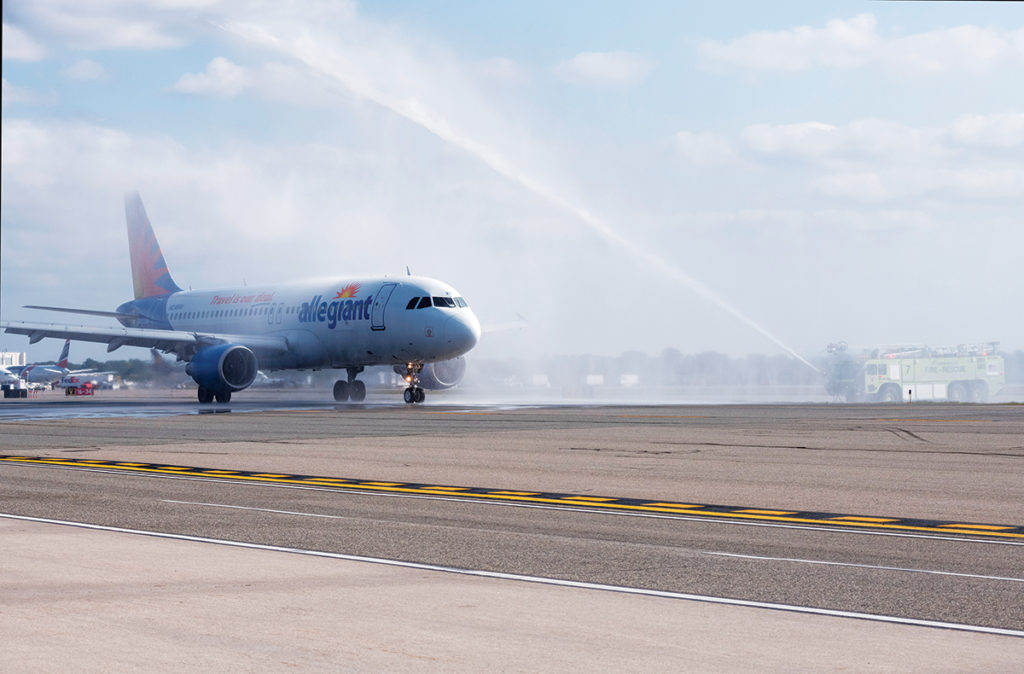
WELCOMING ALLEGIANT: A fire engine shoots a stream of water into the air in celebration of the first flight of Allegiant Air, which serves several airports in Florida with direct service, arriving at T.F. Green Airport. / PBN PHOTO/MICHAEL SALERNO[/caption]
DISCOUNTED FARES
The recruitment of the four airlines that came to Green this year was not an accident.
Norwegian Air in July initiated service through Green to several European destinations, including three cities in Ireland, Edinburgh in Scotland and Belfast, Northern Ireland, as well as Bergen in Norway.
Norwegian has also established direct flights to two islands in the French Caribbean, Guadeloupe and Martinique.
Frontier in August established new domestic, direct-route service to Denver, Miami and New Orleans.
Allegiant Air, based in Las Vegas, in early October initiated direct service through Green to St. Petersburg, Fla., Punta Gorda, Fla., and Cincinnati.
The 2-year-old carrier OneJet began direct service to and from Pittsburgh in late October.
Three of those carriers, Norwegian, Allegiant and Frontier, are known for low-fare, no-fuss flights. Their presence hopefully will tilt fares downward for other carriers using the airport, said Ahmad.
Price and availability of flights are critical to attracting passengers to Green, said Ahmad. His strategy is to attract as many passengers as possible to the affordable seats and convenience of the Rhode Island airport.
As CEO of the international airport in New Orleans, where he last worked, he was credited with boosting its direct flights dramatically.
“What these folks are doing is offering $39 fares and $59 fares,” Ahmad said, of the new arrivals. “So, what happens is the other airlines have to react. They can’t just let these folks have their way and let them take over the market.”
The competition is having an impact on other carriers that still dominate Green passenger counts. Recently, Southwest Airlines dropped its price on direct flights to Tampa, Fla., to $39, an apparent effort to compete with the discount carriers that are offering new routes to several locations in Florida.
Is Ahmad’s strategy working?
Passenger counts increased 10 percent in July, the first month that included Norwegian flights.
And he points to the long-term parking lot as further indication that travelers are now coming across state lines to use Green. Parking Lot E has a variety of plates now, Ahmad said, many with Connecticut and Massachusetts plates.
[caption id="attachment_180027" align="alignright" width="300"]
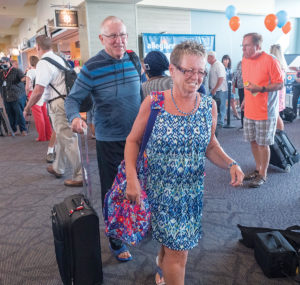
MAIDEN VOYAGE: Husband and wife Ray and Christine Tardie, originally of North Smithfield, now live in Punta Gorda, Fla. They were among the passengers on the first flight of Allegiant Air to arrive at T.F. Green Airport. / PBN PHOTO/MICHAEL SALERNO[/caption]
In early October, Allegiant Air started its direct routes from Green, with an incoming flight from Punta Gorda.
Anyone arriving at the airport to pick up passengers would have heard a promotional announcement in the terminal, the voice of Gov. Gina M. Raimondo extolling the strengths of the local airport.
At the gate, passengers on Allegiant’s nearly full inaugural flight disembarked quickly. Ray and Christine Tardie, who live in Punta Gorda, had flown to Rhode Island to visit their mothers. Normally they would travel out of the Fort Myers airport, but the new service out of their location shaved time off the front end of the trip, as well.
“It’s very convenient,” Christine Tardie said. “And the prices were very good.”
HOST CITY
Warwick, the host city, initially fought an airport expansion. Many of its residents were opposed to the most aggressive options for expanding the runway. Originally, the airport had been considering a pair of perpendicular, 10,400-foot runways, explained Mayor Scott Avedisian, who took office in 2000.
“It didn’t go over well at all,” he said. “We really attempted to reach consensus on what the possibilities were, and what we could make work differently. Part of the compromise was to keep them within their footprint.”
The initial expansion would have allowed the airport to consume property well to the north, east and south, with Main Avenue disappearing altogether, and West Shore Road becoming the city’s major east-west thoroughfare. Those ideas were pushed back, over time, to the footprint that exists today.
By the time construction began, in 2011, the city had embraced the economic potential represented by the extension and upgrades. It has created a new zoning district, a transit-oriented development, around the site called City Centre Warwick.
Avedisian argues that the development that started around the airport prior to the upgrade was facilitated by the understanding that it would happen. He cited the opening of the Hilton Garden Inn, the Ironworks Tavern and others.
“Everyone knew the runway was [coming],” he said. “We knew, with the rezoning of that whole parcel, we were trying to be strategic in what we were missing.”
The city is now working to attract new development to the area. With the work completed, and the airport’s boundaries defined, there is more certainty for developers moving forward, he said. In addition, the airport corporation owns numerous parcels to the north of Airport Road and the west of Post Road that will now be cleared for development. These were lands the airport purchased in anticipation of the longer runway expansion that never materialized.
In the past year, signs of progress have appeared on the City Centre Warwick land.
Construction of a Hilton hotel began this past spring on a site adjacent to the InterLink transit center. Nearby, Proclamation Ale Co. has moved to a newly constructed, 16,000-square-foot brewery on Kilvert Street, and soon will open a 3,000-square-foot tasting room.
‘We have 1 million square feet … ready to do warehousing space with Irish companies.’
SCOTT AVEDISIAN, Warwick mayor
More possibilities await, said Avedisian, who is also pursuing state approval of a Foreign Trade Zone for the City Centre Warwick area, which would expand the tax-free import status of the airport.
He recently returned from a state-organized trade trip to Ireland, where he marketed Warwick and T.F. Green. He was accompanied by an executive with Warwick-based Dean Warehouse Services, and said County Clare-based Chapel Gate Irish Whisky Co. plans to start exports to the United States under the J.J. Corry label through Green this year.
In County Mayo, the Ireland West Regional Airport wants to begin seasonal service to T.F. Green next year, via Norwegian. It is in Knock, near a Catholic shrine that draws 14,000 visitors annually.
While in Ireland, he also met with representatives of Bord Bia, the Irish Food Board, about the export of Irish foods to the U.S. via Green.
The European market, which has opened to Rhode Island through Green, is untapped, Avedisian said. Passengers are important, he added, but so are goods.
“We have 1 million square feet of warehouse space across the street, ready to do warehousing space with Irish companies,” said the mayor.

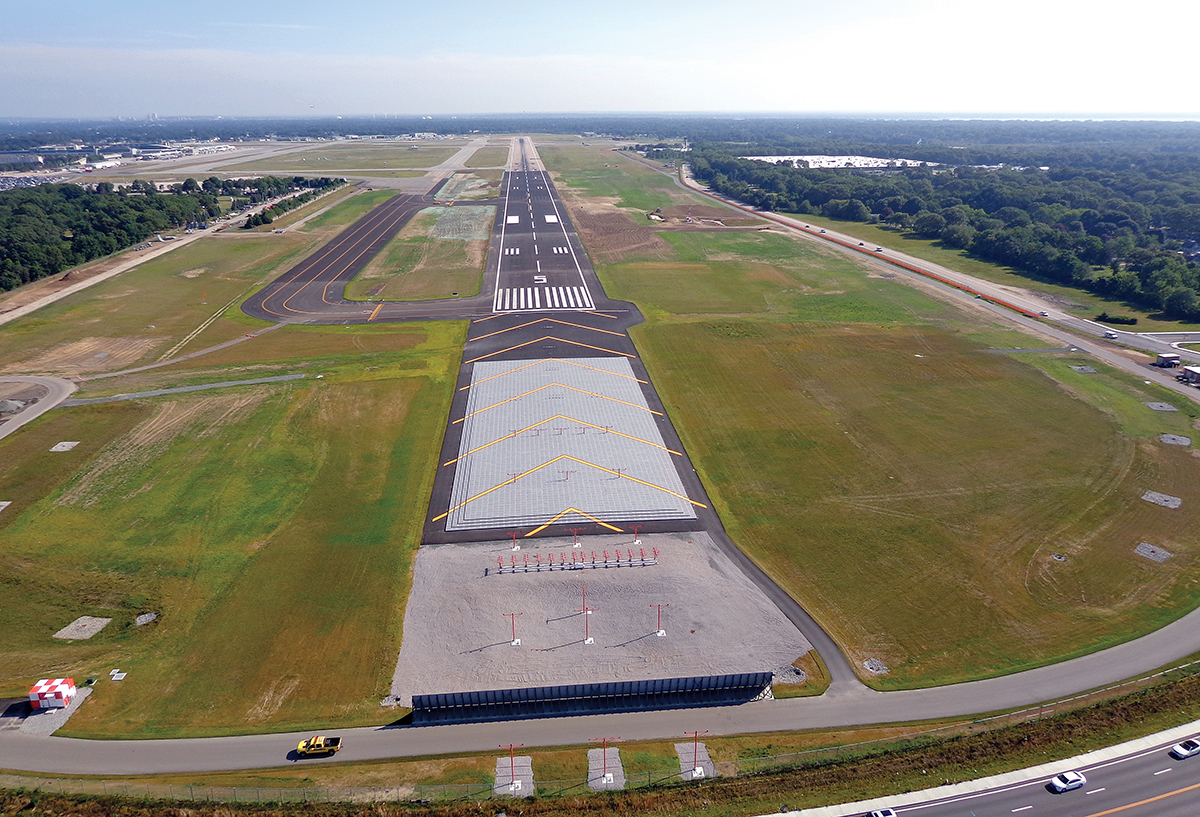
















They fly to PROVIDENCE!!!!!